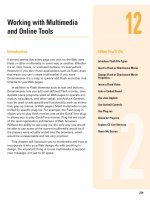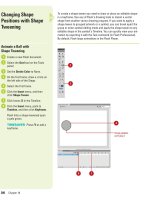HandBooks Professional Java-C-Scrip-SQL part 46 docx
Bạn đang xem bản rút gọn của tài liệu. Xem và tải ngay bản đầy đủ của tài liệu tại đây (80.04 KB, 12 trang )
Ruby in a Nutshell
By Yukihiro Matsumoto
Chapter 5.
Ruby Tools
5.2 Additional Tools
There are other useful tools that don't come bundled with the Ruby standard
distribution. However, you do need to install them yourself.
5.2.1 ri: Ruby Interactive Reference
ri is a online reference tool developed by Dave Thomas, the famous pragmatic
programmer. When you have a question about the behavior of a certain method,
e.g., IO#gets, you can invoke ri IO#gets to read the brief explanation of the
method. You can get ri from
ri [ options ] [ name ]
Here are the ri options:
version,
-v
Displays version and exits.
line-length=n
-l n
Sets the line length for the output (minimum is 30 characters).
synopsis
-s
Displays just a synopsis.
format= name
-f name
Uses the name module (default is Plain) for output formatting. Here are the
available modules:
Tagged
Simple tagged output
Plain
Default plain output
name should be specified in any of the following forms:
Class
Class::method
Class#method
Class.method
method
5.2.2 eRuby
eRuby stands for embedded Ruby; it's a tool that embeds fragments of Ruby code
in other files such as HTML files. Here's a sample eRuby file:
This is sample eRuby file<br>
The current time here is <%=Time.now%>.
<%[1,2,3].each{|x|print x,"<br>\n"}%>
Here's the output from this sample file:
This is sample eRuby file<br>
The current time here is Wed Aug 29 18:54:45 JST 2001.
1
2
3
There are two eRuby implementations:
eruby
The original implementation of eRuby. eruby is available from
Erb
A pure Ruby (subset) implementation of eRuby.
eRuby is available from
The version number may be changed in the future. Unfortunately, the supporting
page
is in Japanese, but you can tell how to
use it from its source code.
Top
Ruby in a Nutshell
By Yukihiro Matsumoto
Chapter
5.
Ruby Tools
5.3 Ruby Application Archive
Do you want to access databases, such as PostgreSQL or MySQL from Ruby? Do
you wish to use such nonstandard GUI toolkits as Qt, Gtk, FOX, etc.? You can
with the Ruby Application Archive (RAA), which has a collection of Ruby
programs, libraries, documentations, and binary packages compiled for specific
platforms. You can access RAA at RAA is
still far smaller than Perl's CPAN, but it's growing every day.
RAA contains the following elements:
The latest 10 items
A list of Ruby applications
A list of Ruby libraries
A list of Ruby porting
A list of Ruby documents
You can enter your program in RAA by clicking "add new entry" at the top of the
RAA page, then following the instructions there. RAA itself is a fully automated
web application written in Ruby. It uses eRuby and PStore as a backend.
Ruby in a Nutshell
By Yukihiro
Matsumoto
Chapter 6. Ruby Updates
Compared to most other languages, Ruby is rather young. As a result, it's still
evolving fairly rapidly.
If you find a bug in Ruby, the first thing to do is to check the bug database and see
if the problem has already been reported. The bug database can be found at
You can either send the bug report
directly from that page or send an email to When you
submit your bug, try to include all relevant information such as source code,
operating system, the output from ruby -v, and what version/build of Ruby you are
running. If you have compiled your own build of Ruby, you should also include
the rbconfig.rb.
The current stable version of Ruby can always be found at y-
lang.org/en/download.html. There are also several mirror sites available.
The current developmental release can be obtained from the CVS (Concurrent
Version System) repository. See for
instructions. You can get CVS tools from
Top
Ruby in a Nutshell
By Yukihiro Matsumoto
Chapter 6.
Ruby Updates
6.1 Summary of Changes
Developmental releases of Ruby always have an odd minor revision number such
as 1.5 or 1.7. Once a developmental release is stable and finalized, it's then
"promoted" to a stable release. Stable releases always have an even minor revision
number such as 2.0 or 3.2. Therefore, releases with even subversion numbers (1.4,
1.6, 1.8, etc.) are stable releases. Releases with odd subversion numbers (1.5, 1.7,
etc.) are developmental versions and are available only from the CVS repository.
At of the writing of this book, the current stable release version is 1.6.5. The
current developmental version is 1.7.1. The changes presented here are currently
reflected in 1.7.1 and will probably remain relatively unchanged in the next stable
releaseersion 1.8.
Top
Ruby in a Nutshell
By Yukihiro Matsumoto
Chapter
6.
Ruby Updates
6.2 Changes from 1.6.5 to 1.7.1
The following information details the changes that are occurring in development
versions 1.7.1 and 1.8 (though 1.8 will have additional changes as well):
Multiple assignment behavior is clarified.
Syntax enhanced to interpret argument parentheses to allow p ("xx"*2).to_i.
break and next extended to take an optional expression, which is used as a
return value of the iterating method and yield, respectively.
The following new methods (or modifications to methods) have been added:
Array#fetch
Array#insert
Enumerable#all?
Enumerable#any?
Enumerable#inject
Enumerable#sort_by
File#fnmatch
MatchData#to_ary
Method#==
Module#include?
Module#included
Module#method_removed
Module#method_undefined
Object#singleton_method_removed
Object#singleton_method_undefined
Proc#==
Proc#yield
Range#to_ary
Range#step
Regexp#options
String#casecmp
String#insert
Symbol#intern
Symbol::all_symbols
SystemExit#status
File::lchmod
File::lchown
IO::for_fd
IO::read
Math::acos
Math::asin
Math::atan
Math::cosh
Math::hypot
Math::sinh
Math::tanh
Process::times
Process::waitall
SystemCallError::===
String#eql? is now always case-sensitive.
Dir::chdir extended to take a block.
NoMethodError raised for undefined method.
Interrupt is a subclass of SignalException (it was a subclass of Exception in
1.6 and prior).
$? now gives Process::Status along with Process::wait2, Process::waitpid2.
Regexp.last_match(n) extended to take an optional argument.
The Digest module has been added as a replacement for the md5 and sha1
modules.
Line-range operation is now obsolete except when used in a one-liner (e.g.,
ruby -e ).
Comparison of exception classes in a rescue clause now uses Module#===.
TCPSocket.new and TCPSocket.open
extended to take an address and a port
number for the local side in optional third and fourth arguments.
Time extended to accept a negative time_t (only if the platform supports it).
Objects that have to_str now behave more like strings.
The Signal module has been added.
Generational garbage collection has been added.
Top
Ruby in a Nutshell
By Yukihiro Matsumoto
Chapter 6.
Ruby Updates
6.3 The Future of Ruby
As Ruby is now used by so many programmers worldwide, I don't see making any
radical changes in the near future. But I'd like to keep Ruby competitive with other
scripting languages.
I don't have a concrete plan for future versions, even 2.0, but I do have plans to fix
some of the remaining drawbacks in the Ruby implementation. For example,
Ruby's internals are too complex to maintain and can be slower than other
languages. I'm going to reimplement the interpreter as a bytecode engine to
simplify interpreter core and boost performance. Also, recently an intriguing but
still vague possibility of a joint backend among Perl, Python, and Ruby has
surfaced.
I'd also like to support M17N (Multilingualization) in Ruby. M17N offers the
ability to handle various human languages along
with the necessary encodings. We
already implemented a prototype that can handle ASCII, UTF-8, and several
Japanese encodings.
The future is unknown, and my imagination is limited. But you can certainly
contribute to the evolution of Ruby via the process called RCR (or Ruby Change
Requests) explained in the next section. We look forward to your contributions.
Top
Ruby in a Nutshell
By Yukihiro Matsumoto
Chapter 6.
Ruby Updates
6.4 Participate in Ruby
Programmers often get ideas on how they'd like to improve Ruby. These ideas are
sometimes useful and interesting, sometimes not. Since the language needs to stay
consistent, I often need to choose which fixes or ideas to add and which to reject.
To make this process easier, we have instituted Ruby Change Requests (RCRs).
When you want to propose a new feature for Ruby, you have to submit your
proposal to The more concrete and
detailed the proposal, the greater chance of success you have of getting it accepted.
The proposal should preferably be consistent, backward-
compatible, and follow the
principle of least surprise.
The RCR page offers a discussion forum and web-based voting box. Once you
submit your proposal, discussion is held on it. If it's decided (with the help of the
community) that your proposal is indeed useful, it will be added to future versions
of Ruby.









